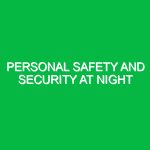In today’s fast-paced world, many industries operate around the clock. Night work has become a necessity in sectors such as construction, manufacturing, and emergency services. However, working in the dark introduces a unique set of challenges, particularly regarding safety and visibility. This is where lighting considerations for night work come into play. Proper lighting is not just a convenience; it’s a critical element in protecting workers and ensuring a safe working environment. In this article, we will delve into the importance of effective lighting, the risks associated with inadequate lighting, safety precautions, best practices, and the regulations that govern lighting standards in night work.
The Importance of Lighting in Night Work
Effective lighting is essential for several reasons. First and foremost, it enhances visibility. When workers can clearly see their surroundings, they are less likely to trip, fall, or make errors that could lead to accidents. A personal anecdote illustrates this point: during a night shift at a construction site, I once witnessed a colleague narrowly avoid a serious injury because a well-placed floodlight illuminated an unexpected hazard—a large hole that had been overlooked in the dark. Such incidents underscore the necessity of proper lighting in preventing accidents.
Moreover, good lighting contributes to productivity. Workers perform better when they can see clearly; this is particularly true in jobs requiring precision and attention to detail. For instance, in the manufacturing sector, assembly line workers rely on adequate lighting to ensure quality control in their tasks. Poor lighting can lead to mistakes, resulting in costly rework or safety violations.
Identifying Hazards and Risks
With the importance of lighting established, let’s explore the potential hazards and risks associated with inadequate lighting during night work. The Occupational Safety and Health Administration (OSHA) emphasizes that poor lighting can lead to various accidents, including slips, trips, falls, and collisions with equipment or other workers.
Common Hazards
- Reduced Visibility: This is the most apparent risk. When visibility is compromised, workers may fail to notice potential hazards, such as uneven surfaces or moving machinery.
- Cognitive Fatigue: Inadequate lighting can strain the eyes, leading to fatigue. This mental exhaustion can impair judgment and reaction times, increasing the likelihood of accidents.
- Increased Risk of Crime: Poorly lit areas can attract criminal activities. Work sites without proper lighting may become targets for theft or vandalism, putting workers at risk.
- Environmental Hazards: Night work often involves outdoor conditions, such as inclement weather. Shadows and darkness can exacerbate the risks of environmental hazards, making it vital to have effective lighting solutions.
Safety Precautions and Best Practices
To mitigate the risks associated with night work, implementing safety precautions and best practices related to lighting is essential. Below are actionable steps that can be taken to enhance safety through effective lighting:
1. Conduct a Lighting Assessment
Before any night work begins, a thorough lighting assessment should be conducted. This involves evaluating the existing lighting conditions and identifying areas that require improvement. Engaging a qualified safety professional can provide valuable insights into the specific lighting needs of the work environment.
2. Utilize Appropriate Lighting Fixtures
Different tasks may require different types of lighting. For example, floodlights are effective for illuminating large outdoor areas, while task lighting might be necessary for close-up work. Consider using LED lights, which are energy-efficient and provide bright, clear illumination. These fixtures not only enhance visibility but also reduce energy costs, making them a practical choice.
3. Ensure Proper Placement of Lights
Positioning lights strategically can make a significant difference. Lights should be placed at angles that minimize shadows and glare. For instance, overhead lights can illuminate work surfaces effectively, while portable lights can be used to light specific tasks. Additionally, ensure that pathways and emergency exits are well-lit to facilitate safe movement.
4. Regular Maintenance
Lighting systems require regular maintenance to remain effective. This includes checking for burnt-out bulbs, ensuring fixtures are clean, and replacing any damaged equipment. Establishing a routine maintenance schedule can prevent lighting failures that could compromise safety.
5. Provide Personal Protective Equipment (PPE)
Even with adequate lighting, workers should be equipped with appropriate PPE, such as reflective vests or hard hats with built-in lights. This equipment enhances visibility and offers additional protection against potential hazards.
Regulations and Standards
Understanding the regulations and standards that govern lighting considerations for night work is crucial for compliance and safety. Various organizations set forth guidelines that help ensure safe working conditions. Here are a few key standards:
1. OSHA Regulations
The Occupational Safety and Health Administration (OSHA) provides regulations that address lighting in the workplace. OSHA standards require employers to provide adequate lighting to ensure that workers can perform their tasks safely. This includes guidelines for both indoor and outdoor lighting levels.
2. American National Standards Institute (ANSI)
ANSI has established standards for lighting that outline the minimum illumination levels required for different types of work environments. These standards are vital for maintaining safety and ensuring that workers can see adequately to perform their jobs.
3. National Fire Protection Association (NFPA)
The NFPA has regulations regarding lighting in emergency situations. Proper emergency lighting is essential to guide workers to safety in case of an evacuation. Compliance with these regulations is critical for ensuring the safety of all personnel on site.
Conclusion
In conclusion, lighting considerations for night work are an integral part of the Health, Safety, and Environment (HSE) domain. The risks associated with inadequate lighting can be severe, ranging from accidents to decreased productivity. By implementing effective lighting solutions, conducting regular assessments, and adhering to regulatory standards, organizations can create a safer work environment for their employees. Investing in proper lighting is not just a compliance issue; it’s a commitment to the well-being of workers. As industries continue to operate in the dark, it becomes increasingly important to prioritize lighting as a fundamental aspect of workplace safety.


